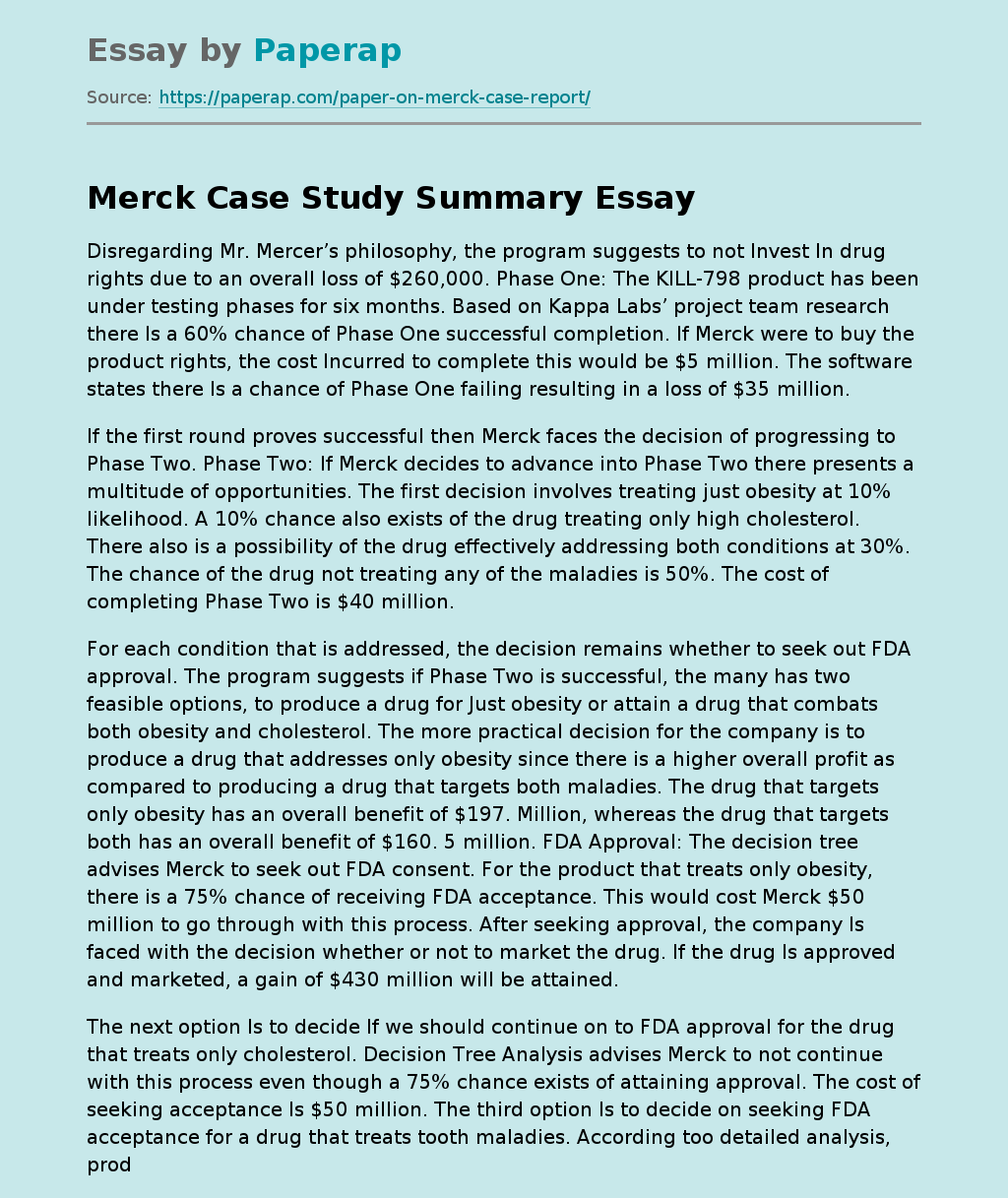Merck Case Study Summary
Disregarding Mr. Mercer’s philosophy, the program suggests to not Invest In drug rights due to an overall loss of $260,000. Phase One: The KILL-798 product has been under testing phases for six months. Based on Kappa Labs’ project team research there Is a 60% chance of Phase One successful completion. If Merck were to buy the product rights, the cost Incurred to complete this would be $5 million. The software states there Is a chance of Phase One failing resulting in a loss of million.
If the first round proves successful then Merck faces the decision of progressing to Phase Two. Phase Two: If Merck decides to advance into Phase Two there presents a multitude of opportunities. The first decision involves treating just obesity at 10% likelihood. A 10% chance also exists of the drug treating only high cholesterol. There also is a possibility of the drug effectively addressing both conditions at 30%. The chance of the drug not treating any of the maladies is 50%. The cost of completing Phase Two is million.
For each condition that is addressed, the decision remains whether to seek out FDA approval. The program suggests if Phase Two is successful, the many has two feasible options, to produce a drug for Just obesity or attain a drug that combats both obesity and cholesterol. The more practical decision for the company is to produce a drug that addresses only obesity since there is a higher overall profit as compared to producing a drug that targets both maladies. The drug that targets only obesity has an overall benefit of 7.
Million, whereas the drug that targets both has an overall benefit of $160. 5 million. FDA Approval: The decision tree advises Merck to seek out FDA consent. For the product that treats only obesity, there is a 75% chance of receiving FDA acceptance. This would cost Merck $50 million to go through with this process. After seeking approval, the company Is faced with the decision whether or not to market the drug. If the drug Is approved and marketed, a gain of $430 million will be attained.
The next option Is to decide If we should continue on to FDA approval for the drug that treats only cholesterol. Decision Tree Analysis advises Merck to not continue with this process even though a 75% chance exists of attaining approval. The cost of seeking acceptance Is $50 million. The third option Is to decide on seeking FDA acceptance for a drug that treats tooth maladies. According too detailed analysis, producing this drug Is also a viable option, although the benefit would be less than producing for only obesity.
Sensitivity Analysis: The first analysis conducted was on attaining success in Phase I Nils apneas Is extremely sensitive up until purportedly up until tens percentage, the expected value is negative. Any probability greater than 60% results in a positive expected value. If the probability increases by 1%, the program decision will change to suggest the company to move forward. For the second sensitivity analysis, we set the option with the highest possibility as the constant, which is the decision to produce neither drug.
This option also proves to be very sensitive at the 50% probability mark. If the percentage were to be greater than 50%, then it would not be optimal to move forward. The last analysis involved the probability of both drugs receiving FDA approval. Like the previous two analysis, a value higher than 60% will result in an expected value that is positive. This results in the drugs receiving acceptance. Consensus: According to Decision Tree footwear, the optimal recommendation is to not purchase drug rights.
Merck Case Study Summary. (2019, Dec 05). Retrieved from https://paperap.com/paper-on-merck-case-report/

